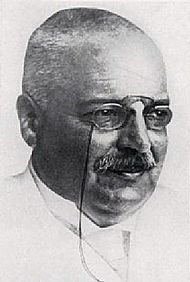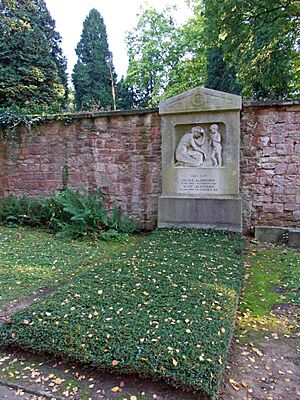Alois Alzheimer facts for kids
Quick facts for kids
Alois Alzheimer
|
|
|---|---|
 |
|
| Born | 14 June 1864 Marktbreit, Kingdom of Bavaria
|
| Died | 19 December 1915 (aged 51) |
| Education | |
| Known for | First published case of "presenile dementia" (Alzheimer's disease) |
| Medical career | |
| Profession | Psychiatrist, physician |
| Institutions |
|
| Sub-specialties | Neuropathology |
| Signature | |
 |
|
Alois Alzheimer (born June 14, 1864 – died December 19, 1915) was a German psychiatrist and neuropathologist. A psychiatrist is a doctor who studies and treats mental illnesses. A neuropathologist studies diseases of the nervous system, especially the brain.
He worked with another famous doctor, Emil Kraepelin. Alzheimer is famous for finding the first case of a brain disease. This disease was later named Alzheimer's disease by Kraepelin.
Contents
Early Life and Education
Alois Alzheimer was born in Marktbreit, Bavaria, Germany. His birthday was June 14, 1864. His father, Eduard Román Alzheimer, worked as a notary public. A notary public is someone who can legally witness signatures on documents.
When Alois was young, his family moved to Aschaffenburg. This move helped their children go to a good school. After finishing high school in 1883, Alzheimer studied medicine. He went to universities in Berlin, Tübingen, and Würzburg.
In his last year of university, he was part of a fencing club. Fencing is a sport where people fight with swords. He even got a fine once for being too noisy with his team! In 1887, Alois Alzheimer earned his medical degree from Würzburg.
Career
After medical school, Alzheimer worked for a few months helping women with mental illnesses. Then, he got a job at a mental asylum in Frankfurt. An asylum was a hospital for people with mental health conditions.
At this asylum, he met another doctor named Franz Nissl. They worked together to study the brain. They looked closely at how the brain's outer layer, called the cerebral cortex, looked when it was healthy and when it was sick. Alzheimer also helped start a medical journal.
While in Frankfurt, Alzheimer also met Emil Kraepelin. Kraepelin was a very well-known German psychiatrist. Kraepelin became a mentor to Alzheimer, meaning he guided him. They worked closely together for many years.
In 1903, Kraepelin moved to Munich to work at a royal psychiatric hospital. He asked Alzheimer to join him there. Kraepelin was studying mental illnesses in older patients. Alzheimer was more interested in studying brain changes in the lab.
In 1904, Alzheimer became a full professor at the Ludwig Maximilian University of Munich. He moved to the Silesian Friedrich Wilhelm University in Breslau in 1912. There, he became a professor of psychiatry and led a special institute. Sadly, his health got worse soon after he arrived.
Auguste Deter
In 1901, Alzheimer met a patient named Auguste Deter at the Frankfurt asylum. She was 51 years old. She had very strange behaviors. She also kept losing her short-term memory. Alzheimer became very interested in her case.
The Frankfurt asylum was expensive for Auguste Deter's husband. He wanted to move her to a cheaper place. But Alzheimer wanted to keep studying her. So, he made a deal. He paid for her stay at the asylum. In return, he would get her medical records and brain after she died.
Auguste Deter died on April 8, 1906. Her records and brain were sent to Alzheimer in Munich. He was working in Kraepelin's lab. With two other doctors, he used a special new stain called the Bielschowsky stain. This stain helped them see tiny clumps and twisted fibers in her brain. These brain changes became known as amyloid plaques and neurofibrillary tangles. These changes are now key signs of what we call Alzheimer's disease.
Findings
On November 3, 1906, Alzheimer shared what he found about Auguste Deter's brain. He spoke at a meeting in Tübingen, Germany. He talked about the brain changes and symptoms of this type of memory loss. However, the doctors at the meeting did not seem very interested.
After his talk, Alzheimer wrote a short paper about his findings. In 1907, he wrote a longer paper with more details. The disease was not called Alzheimer's disease until 1910. That's when Kraepelin named it in his book, Handbook of Psychiatry. By 1911, doctors in Europe and the US were using Alzheimer's description to diagnose patients.
Contemporaries
Other doctors were also studying similar brain conditions. An American doctor named Solomon Carter Fuller gave a similar report a few months before Alzheimer. Another German psychiatrist, Oskar Fischer, also reported cases of memory loss in older people around 1907.
Alzheimer and Fischer had different ideas about the disease. But Alzheimer died young, so they never got to meet and talk about their ideas. Some Spanish doctors, like Nicolás Achúcarro and Gonzalo Rodríguez Lafora, also trained with Alzheimer and Kraepelin.
Other Interests
Alzheimer had many different medical interests. He studied diseases of the brain's blood vessels. He also looked at early forms of memory loss and brain tumors. He was interested in forensic psychiatry, which deals with mental health and the law. He also studied epilepsy.
Alzheimer was known as a top expert in studying body tissues under a microscope in Europe. His friends and colleagues knew him as a dedicated professor who enjoyed smoking cigars.
Personal Life and Death
In 1894, Alzheimer married Cecilie Simonette Nathalie Geisenheimer. They had three children together. Sadly, Cecilie died in 1901.
In August 1912, Alzheimer became very ill on a train. He was on his way to the University of Breslau. He had been appointed a professor there. He likely had a serious infection that led to heart problems. He never fully recovered from this illness.
Alois Alzheimer died on December 19, 1915, at age 51. He passed away in Breslau, which is now in Poland. He was buried next to his wife in the Frankfurt Main Cemetery.
See also
 In Spanish: Alois Alzheimer para niños
In Spanish: Alois Alzheimer para niños
- Gaetano Perusini
- German inventors and discoverers


